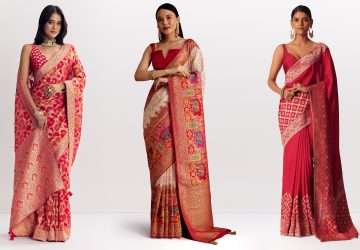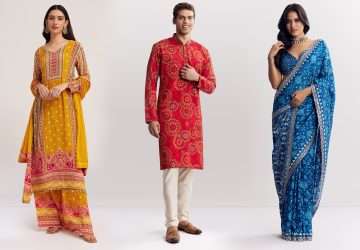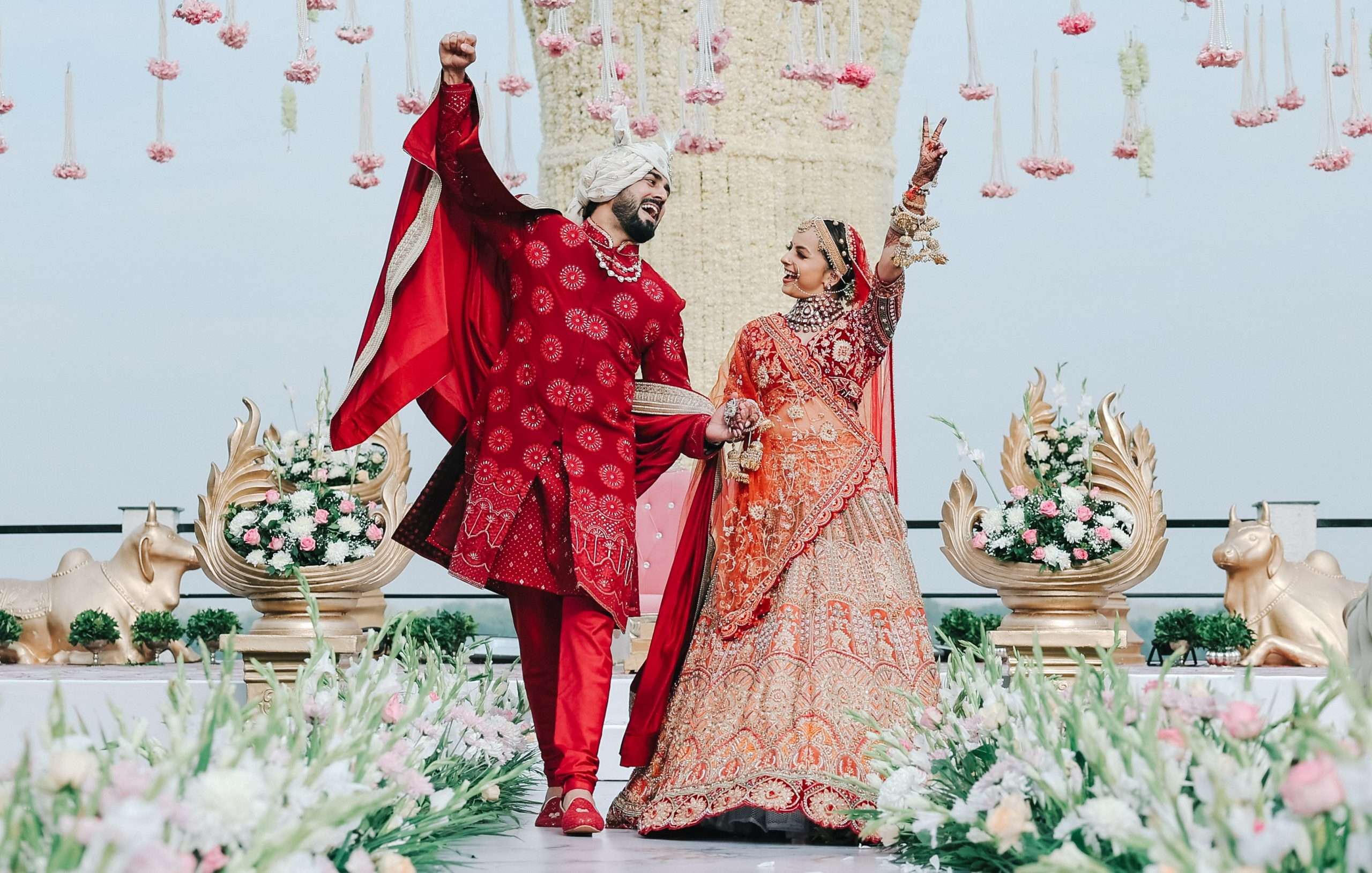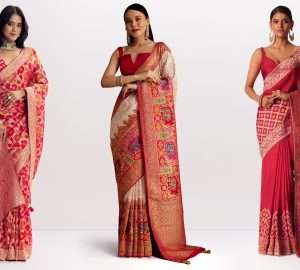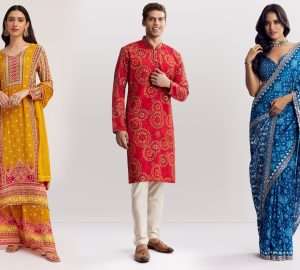Indians are all about that charm and royalty with Indian codded right in their blood—The Big Fat Indian Wedding, we live up to that name in all senses. Our Indians are the dreamiest of all, and our diversity makes them even more special. We are rooted in our own traditions. Gujaratis, being from the land of colours, food and culture, are very prominent in their wedding celebrations. Filled with fun and joy, the festive nature of Gujaratis is reflected in their wedding rituals and practices as well. Today, we have curated a list of customs, rituals and ceremonies that are an important part of Gujarati weddings.
The Custom of Chandlo Maati
The Gujarati wedding festivities commence with a vibrant ritual called “Chandlo Maati.” The bride’s father and four more male relatives visit the groom’s home. They have a steel container or “Maatli” in their hands, wherein is filled with sweets and gifts for the bride’s groom and his family. The bride’s father then applies a red-coloured circle to the centre of the groom’s forehead.
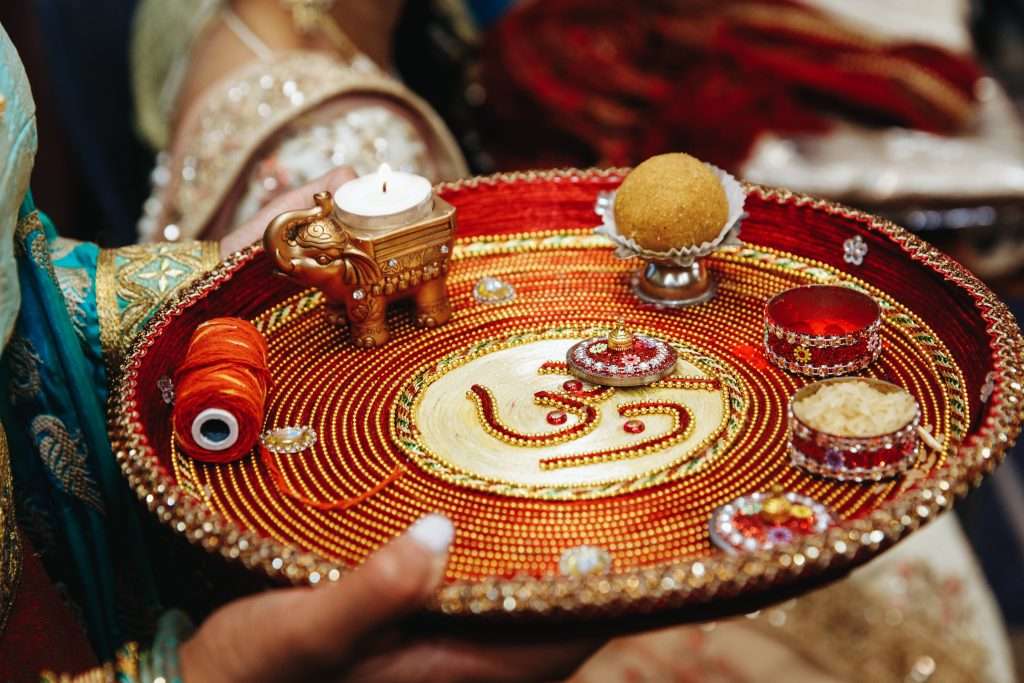
That’s when the formal acceptance takes place from the bride’s side and the “Maatli” is handed over to the groom—as a gesture of love, Shagun and some money are given. The Chandlo Maati ceremony isn’t just a ritual; it’s a celestial alignment. It’s the cosmic moment when the stars align, and the date of the marriage is divinely ordained.
The Custom of Gol Dhana
Now, if you are not too familiar with Gujarati weddings, then this may be new for you, but we want you to get engraved with your rituals (or maybe your partners). Just like an engagement ceremony, “Gol Dhana” is quite similar to that, it’s a pre-wedding celebration in Gujarati weddings. Now, “Gol Dhana” might seem confusing, but what does it actually mean? Well, to simply translate it, it means “Jaggery and Coriander Seeds.” Yes, these items will be distributed during the event.
So, this makes you curious to know more about the ceremony, huh? Then, let’s dive into the fun part of it and why it is so important.
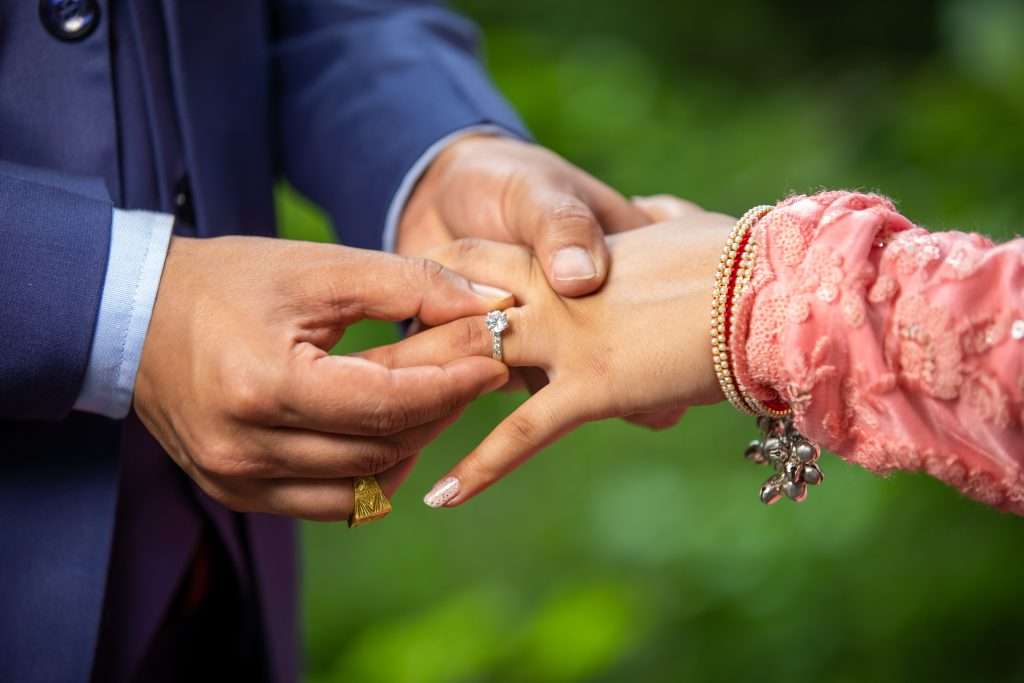
First off, the sweet gestures, when the bride’s family brings gifts and sweets to the groom’s house, it’s the ultimate symbol of the couple’s forever and a relationship filled with sweetness. But is doing the Gol Dhana ceremony important?
The importance of doing so has its roots in exchanging gifts like gold and silver wedding jewellery and officially commencing the beginning of other upcoming ceremonies. This ceremony is an extremely important ritual to follow in order to have a fruitful relationship in your marriage. As a couple, you have to seek blessings from five married women in the family. The ceremony is then followed by Ganesh Sthapana and Grah Shanti.
The Mehendi Ceremony
Let’s talk about the fun part of all the Shaddi shenanigans!
The Mehendi ceremony is your cue to dance to old-school Bollywood music, to the tune of “Mehendi lagake rakhna” and “Tumhe Jo Maine Dekha.” Along with the nostalgia of the 00s, it’s fun to dance to the beats of these songs—filled with entertainment, joy, and hearty laughter. Just like any other Mehendi function at weddings, Gujaratis, too, celebrate it with great enthusiasm.
The bride’s family hosts this Mehendi ceremony two days prior to the wedding. This ceremony is all about sharing stories and expressing cultural traditions.

The crucial part of this ceremony is obviously the Mehendi. The bride’s family members, including the bride’s sisters, cousins, and friends, all come together to create intricate designs on their hands. These designs are created by professionals. The bride adorns her hands and feet with long and detailed designs. Along with these intricate designs, the name or initials of the groom is written with the henna.
While the bride’s henna designs are often elaborate, the groom too applies henna on his hand and can choose simpler patterns. The designs are not ordinary patterns they, in fact, share cultural significance. For example, peacocks represent beauty and pride, flowers signify jo,y and paisleys represent fertility.
The ‘Sangeet Sandhya’
Sangeet Sandhya is filled with musical madness for the Gujaratis, a fun-filled evening that is eagerly awaited. Here, this ceremony is solely dedicated to songs and dancing, that’s what we call a Sangeet Sandhya or a Sangeet Ceremony, while some people do call it ‘Sanji‘ as well. The Sangeet is celebrated one day after the Mehendi and a day prior to the wedding.
But what actually takes place at the Sangeet Sandhya? Gaana—the families come together to sing folk songs, play a lot of Dandiya and dance to the most loved Garba beats (well, ain’t that fun now!) Milan—Sanji is the first occasion where both sides of the families come together, not only to show their moves but to also break the ice by getting to know each other.
Pithi
Pithi—a time for fun, laughter and joyous moments, also known as the Haldi ceremony in most Indian traditions. Gujarati weddings celebrate Pithi just a day before the wedding, at both the houses, bride and groom. The bride and groom are placed at a low seat, and all the relatives have to cover the duo’s face, palms, arms, hands and feet with turmeric, sandalwood, rosewater, herbs and sometimes even gram flour.
Did you know? The Pithi is traditionally prepared by both sides’ parental uncle’s wife, also called Kaki in most Hindu cultures. So, after the bride and groom are doused with the Pithi, they are given a holy bath. Turmeric is believed to cleanse and purify the skin, leaving the couple a radiant glow for their wedding day. We’re recommending our top favourite Gujarati wedding outfits for men and women to celebrate your Haldi ceremony:
Mandap Mahurat
We Indians believe that mother nature is the divine feminine, the giver of life. On the Mandap Mahurat, also known as Mangal Mahurat, both family members seek blessing from Mother Earth at their respective homes and worship the piece of land. The reason behind doing so is to offer prayers to Lord Ganesha—the God who removes every obstacle there is or might occur. What truly makes a grand and captivating statement are these styles—this year’s ultimate portrait-perfect Gujarati lehenga for wedding and Gujarati groom outfit:
The Mandap is essentially a sacred altar where the bride and groom perform the Saath Pheras or Saptapadi, symbolising their journey through life together. The Mandap is a spiritual realm, a haven that brings together a union of two separate souls, making them one. They worship the land where they create the wedding Mandap and ask for Mother Earth’s permission to carry out the rituals peacefully.
Mosalu and Mameru
Just the latest greatest Indian wedding took place of “The Ambani”. The Mosalu and Mameru in a Gujarati wedding has been a traditional journey for years, a custom that’s rooted in its historical legacy with the Gujaratis and is quite similar to the Marwari wedding ceremony “Mahira Dastoor”.
This custom usually involves the bride’s maternal uncle, also known as Mama and her maternal aunt’s husband, also called Mousa, having to visit the bride’s home a day before the wedding.
Now, this is done so that the Mosalu and Mameru come to bless the couple with gifts and offerings like the bridal traditional Panetar saree, jewellery, ivory or white chura, sweets, dry fruits, and so much more. This gift is beautifully wrapped in a grand bridal trousseau tray.
In simple words, Mosalu and Mameru are basically a testament to the strong familial bonds in Indian weddings. These occasions seemingly bring extended families closer together, fostering a sense of belonging and togetherness and underscoring the importance of family in Indian culture and the joy of shared celebrations.
The Jaan Ceremony
Gujaratis are full of fun and love, so when there is a wedding in the family, it’s a Dhamal! The Jaan ceremony is a playful tradition. The groom is welcomed with enthusiasm as he arrives with his Baraat at the venue, riding on his luxuriously decorated ghodi and with the Pelli Godugu (canopy) which means a wedding umbrella. He is greeted by the bride’s mother with a plate full of customs of aarti and then proceeds to apply the tikka on his forehead for blessings.
For the fun part of the tradition, the groom’s mother-in-law tries to humorously grab the groom’s nose while he tries to avoid being caught. This playful game also has a deeper meaning, it is a reminder to the groom that she is giving the hand of her precious daughter and stresses the virtues of humility and gratitude. This ritual is called the Jaan or Agaman ritual.
The Antarpaat Ceremony
Antarpaat is a ritualistic curtain through which the couple cannot see until the auspicious moment of coming together. Antarpaat serves to build a sense of waiting and adds mystery to the overall ceremony. The bride is first taken to the Mandap, where the bride and groom are completely covered by an opaque cloth and sacred mantras are chanted for them. Eventually, in this ritual itself, this opaque cloth is slowly drawn down, and so their union in marriage starts.

The Jaimala
The marriage ceremony of the people of Gujarat starts formally with the performance of the Jaimala ritual in which garlands are exchanged between the bride and the groom. The exchange is first made by the groom, who stands on a raised platform. Or his friends carry him as if to make it playfully difficult for the bride to put the garland on him. Then he gets down to stand on an equal level, which indicates equality.

Kanyadaan
Kanyadaan is a very special ritual performed during Gujarati weddings, where the bride’s father formally gives his daughter to the groom, entrusting him with his greatest possession. It’s the sweet moment of trust and responsibility shared by the two men.
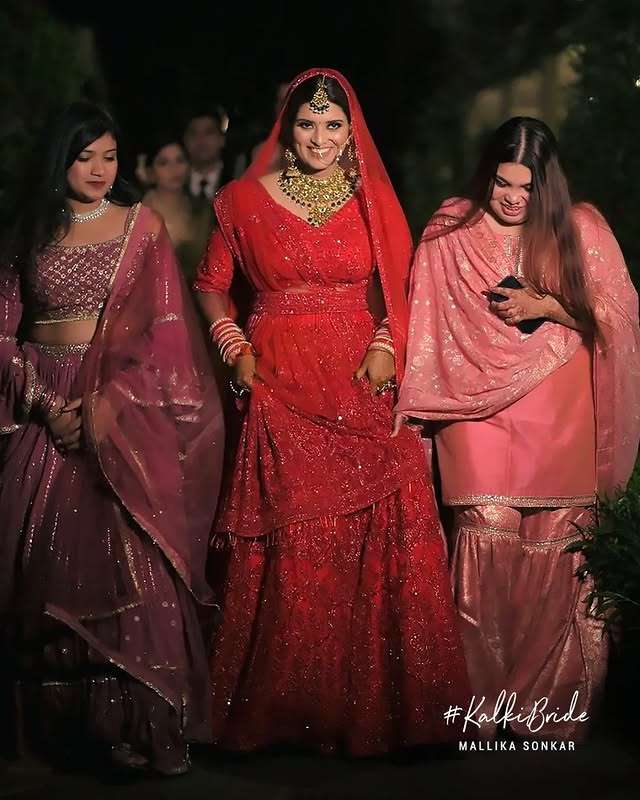
The Ceremony of Madhuparka or Panchamrut
One of the many traditions and customs observed during a Gujarati wedding about the groom involves washing his feet with water and milk by one of the family members of the bride and he is then given a special drink by the bride’s sisters consisting of milk, honey, ghee, sugar, and yoghurt.
The ceremony of Juta Chuppai
Joota chupai, the playful pre-wedding ritual of an Indian wedding for Gujarati cultures, is considered one of the most awaited routines by the sisters and brides. They play games by stealing the groom’s shoes stealthily with extraordinary tricks and not letting him watch. The laughter and excitement at the wedding function increase as these sisters demand dowry to recover the shoes they have stolen in secret.
Hasta Milap, Mangal Pheras, and Saptapadi
After the Kanyadaan, a priest fastens the pallu of the bride to that of the shawl of the groom, to seal their relationship. They keep holding hands as mantras are chanted and rose petals and puffed rice grains are showered around them by family members. There are four Pheras in this Gujarati ritual, which forms the sacred procession around the blazing fire, expressing duty, wealth, desires and liberation. Lastly, they also take 7 steps together on Saptapadi, thus taking vows on each step before finally seeking blessing from the elders of the family.
They especially receive their blessings from 7 married women. While blessing the bride, they say “Akhanda Saubhagyavati Bhava”, meaning ‘may you remain gloriously married forever. At the end of the main rituals of the Gujarati wedding, the bride and groom feed each other sweets.
The Chero Pakaryo Ceremony: In Chero Pakaryo, the groom catches hold of the saree of his mother-in-law. It is a move to ask for more gifts. All the gifts and cash then fill her saree, which she hands over to the groom and his family.
The Vidaai: Viddai is a poignant ritual of the wedding ceremony in Gujarat, where the bride has to leave her childhood home to start a new life with her husband. Hysterical, tears pouring down from the bride, her parents, and others. The bride takes rice in her hands and throws it backwards which is caught by women in their pallus which is a sign of appreciation from the daughter towards her family.
Gharni Laxmi: During the post-wedding ceremony, in this particular Gujarati celebration, the bride is invited into her husband’s home as Goddess Laxmi, who is to bring prosperity and good fortune within the house. The mother-in-law keeps an earthen pot containing rice near the door entrance, and she then requests the bride to pour out the pot by stepping upon it with her right foot. This gesture means wealth and represents the bride as the daughter who will accept the responsibility for the new house.
Aeki Beki: The newlywed couple has to play after Ghar Nu Laxmi, called Aeki Beki. In that game, they mix the tray of water along with milk and sindoor with several coins placed along with the ring, asking the couple to find the ring. Then whoever finds the ring four out of seven times would have ruled the house. Prayers are offered at the end of the day for God’s blessings upon the newlywed couple.
Going All The Way Into Gujarati Weddings
There are a number of ways you can dress in a Gujarati saree for a wedding, in different ways, now, you’ve got the Gharchola Saree, Panetar Saree, Bandhani Saree, Gujarati Lehenga for the wedding and Patola Sarees. Gujarati bridal dresses have a lot of traditional and contemporary options to choose from. Each Gujarati bridal wear is no less than fascinating.
Gujarati wedding outfits aren’t just restricted to women; Gujarati groom outfits are also in varied styles. Traditionally, Gujarati wedding outfits for men have been kurta or kediyu with a dhoti beneath for centuries. The Gujarati wedding dress for men is adorned with zari work or has luxurious border designs and a few embellishments like a brooch, which add to the charm.
![]()

